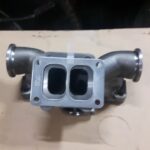Continental Sim2k-25x and SIM2K-26x Engine Control Units (ECUs) are commonly found in petrol-powered Kia and Hyundai vehicles. These ECUs utilize Infineon Tricore microcontrollers and require specialized tools for reading and writing flash memory. This article details various flashing methods for these modules, focusing on FullFlash reading/writing and calibration capabilities.
SIM2K Variations and Flashing Methods
Different SIM2K versions exist, each with specific flash memory sizes and compatible flashing methods. Understanding these distinctions is crucial for successful ECU modification.
Continental SIM2K-25x with TC1782 MCU (FID: 152 & 150)
The SIM2K-250/251/253/258/259 series utilizes the Infineon Tricore TC1782 MCU, featuring 2.5Mb of internal flash memory. Two primary flashing methods are available:
FID 152: Full OBD Flashing: This method enables FullFlash reading and writing (calibration and software areas) entirely through the vehicle’s OBD diagnostic connector. No ECU disassembly is required. Checksum and CVN corrections are automatically performed during the writing process. However, compatibility is not guaranteed for ECUs previously flashed with other tools.
FID 150: BSL Mode Flashing: This method allows FullFlash reading and writing of the calibration area in Boot Strap Loader (BSL) mode. Unlike FID 152, BSL mode requires opening the ECU for direct access. Checksum and CVN correction is still handled automatically.
Continental SIM2K-26x with TC1791 MCU (FID: 252 & 151)
The SIM2K-260/261 series utilizes the Infineon Tricore TC1791 MCU, featuring 4Mb of internal flash memory. Similar flashing methods apply:
FID 252: Full OBD Flashing: Similar to FID 152, this method allows FullFlash reading and writing (calibration and software) via the OBD port, without opening the ECU. Automatic checksum and CVN correction are included. Compatibility issues may arise with ECUs previously modified by different tools.
FID 151: BSL Mode Flashing: This method facilitates FullFlash reading and calibration area writing in BSL mode. ECU disassembly is necessary for direct access. Checksum and CVN correction are automatically performed.
Important Considerations for SIM2K Flashing
Hardware and Software Requirements: BSL mode flashing (FIDs 150 and 151) often requires specialized hardware like the BITS001 power adapter and specific flashing tools like the Scanmatik 3. While compatibility with other tools like Openport 2.0 and Bosch VCM2 might exist, stable operation is primarily ensured with the recommended setup.
Previous Flashing Attempts: ECUs previously flashed with non-approved tools might encounter compatibility issues with the methods described above, particularly with Full OBD flashing.
Conclusion
Flashing Continental SIM2K ECUs requires careful consideration of the specific module version and available flashing methods. While Full OBD flashing offers convenience, BSL mode provides an alternative for specific scenarios. Understanding the hardware and software requirements, along with potential compatibility issues, is essential for a successful flashing procedure.

